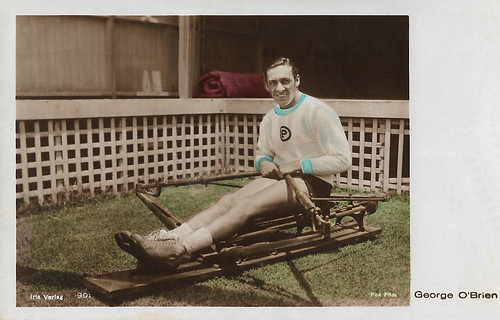
Austrian postcard by Iris Verlag, no. 991. Photo: Fox Film.
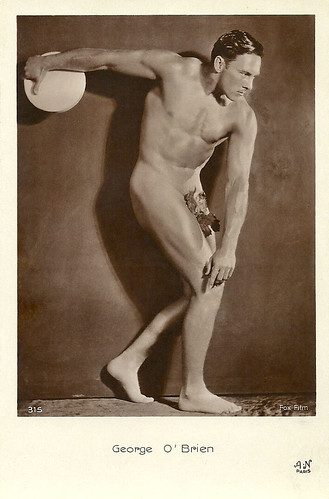
French postcard by A.N., Paris, no. 315. Photo: Max Munn Autrey / Fox Film.
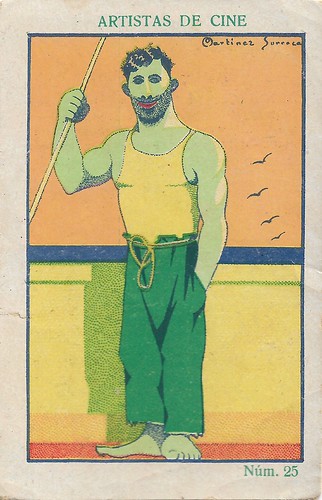
Spanish collectors card by Chocolates Amatller, Barcelona, in the 'Artistas de cine' series, no. 25: George O'Brien. Image: Martinez Surroca.
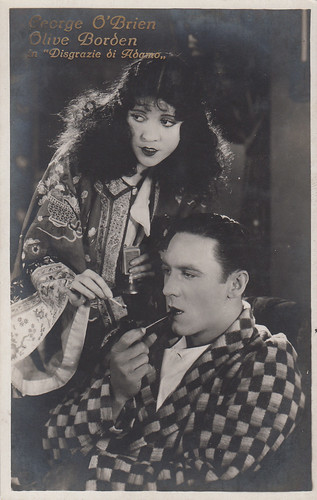
Italian postcard by G.B. Falci Editore, Milano, no. 637. Olive Borden and George O'Brien in Fig Leaves (Howard Hawks, 1926). Collection: Marlene Pilaete.

French postcard by CAF, Lisonne, no. 205. George O'Brien in Sunrise (F.W. Murnau, 1927).

German postcard by Ross Verlag, no. 1340/1, 1927-1928. Photo: Witzel, Hollywood / Fox.

German postcard by Ross Verlag, no. 5205/1, 1930-1931. Photo: Fox.
Hollywood's first perfect male physique
George O'Brien was born in San Francisco, California, in 1899. He was the oldest son of Daniel J. and Margaret L. (née Donahue) O'Brien. O'Brien's father later became the Chief of Police for the City of San Francisco and ordered the arrest of Roscoe 'Fatty' Arbuckle in September 1921 at the scandalous Labour Day party held by Arbuckle. After he retired from that office, Dan was the Director of Penology for the State of California.
In 1917, George enlisted in the United States Navy to fight in World War I, serving on a submarine chaser. He volunteered to act as a stretcher-bearer for wounded Marines and was decorated for bravery. After the war, O'Brien became the Light-Heavyweight boxing champion of the Pacific Fleet.
O'Brien came to Hollywood in his early twenties hoping to become a cameraman and worked as an assistant cameraman for a while, for both Tom Mix and Buck Jones. He began his acting career in bit parts and as a stuntman. One of his earliest roles was in the drama Moran of the Lady Letty (George Melford, 1922), most notable for starring Rudolph Valentino. In 1924, O'Brien received his first starring role in the drama The Man Who Came Back (Emmett J. Flynn, 1924) opposite the English actress Dorothy Mackaill. That same year he was chosen by the famed film director John Ford to star in The Iron Horse (1924) opposite Madge Bellamy. The film was an immense success at the box office and O'Brien made nine more films for Ford, including the great Western 3 Bad Men (1926).
The athletic O'Brien was truly Hollywood's first perfect male physique. In 1927, he starred in F. W. Murnau's Sunrise: A Song of Two Humans (1927) opposite Janet Gaynor, which won three major Academy Awards and remains his most famous film. He also played the lead in the New York City epic East Side, West Side (Allan Dwan, 1927) opposite Virginia Valli. O'Brien often starred in action and adventure roles alongside such popular actresses of the era as Alma Rubens, Anita Stewart, Dolores Costello, Madge Bellamy, Olive Borden (with whom he was linked romantically during the 1920s), and Janet Gaynor.
With the advent of sound, his popularity was sliding. Tony Fontana at IMDb: "With his rugged looks and physical size, he was soon a Western Cowboy Star. He was in some of the best stories ever written, Riders of the Purple Sage (Hamilton MacFadden, 1931), and in some of the worst." So, throughout the 1930s, O'Brien was a consistent Top Ten box-office draw appearing in scores of Westerns, often atop his horse named Mike. He would appear in a few films outside the horse set, such as Ever Since Eve (George Marshall, 1934) with Mary Brian, but those roles would be few.

German postcard by Ross Verlag, no. 3836/1, 1928-1929. Photo: Fox.
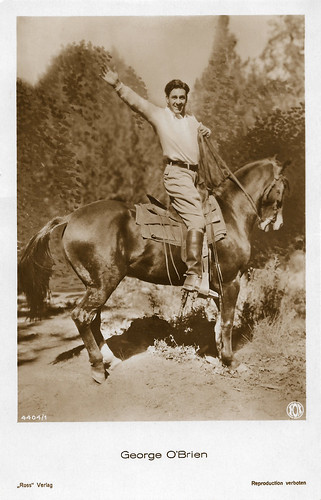
German postcard by Ross Verlag, no. 4404/1, 1929-1930. Photo: Fox.

Austrian postcard by Iris Verlag, no. 937. Photo: Fox-Film. George O'Brien in Sunrise (F.W. Murnau, 1927).

Austrian postcard by Iris Verlag, no. 991. Photo: Fox Film.
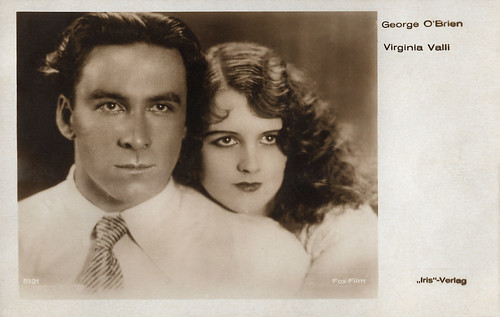
Austrian postcard by Iris-Verlag, no. 5121. Photo: Fox-Film. George O'Brien and Virginia Valli in Paid to Love (Howard Hawks, 1927).

Austrian postcard by Iris Verlag, no. 5304. Photo: Witzel, Hollywood / Fox.
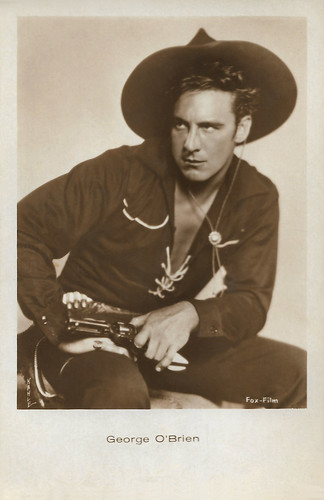
Austrian postcard by Iris-Verlag, no. 5770. Photo: Kahle / Fox.
Directed by his old friend and mentor John Ford
During World War II, George O'Brien re-enlisted in the United States Navy, where he served as a beach master in the Pacific and was decorated several times. He left service with the rank of commander. He later joined the United States Naval Reserve and retired with the rank of captain in 1962, having four times been recommended for the rank of admiral.
Following his service in World War II, O'Brien would occasionally take featured parts in films directed by his old friend and mentor John Ford, including Fort Apache (1948), starring John Wayne and Henry Fonda, She Wore a Yellow Ribbon (1949), and Cheyenne Autumn (1964), starring Richard Widmark and Carroll Baker.
O'Brien's last leading role was in Gold Raiders (Edward Bernds, 1951), with top-billed O'Brien handling the action and the Three Stooges (Shemp Howard, Larry Fine, and Moe Howard) doing comedy routines in a feature film more or less evenly dividing screen time between O'Brien and the Stooges. While serving in the Naval Reserve, O'Brien took on a project for the Department of Defense as part of President Eisenhower's 'People to People' program. He was the project officer for a series of orientation films on three Asian countries. One of these films, on Korea, was directed by his old friend, John Ford. The other two countries covered were Formosa (Taiwan) and the Philippines.
In the 1920s, O'Brien dated actress Olive Borden for many years, and most thought they would marry. For some reason (some say his family did not approve of Olive) they ended their relationship and he eventually married actress Marguerite Churchill in 1933. Their first child, Brian, died 10 days after his birth. Daughter Orin O'Brien became a double bassist for the New York Philharmonic. Their youngest child Darcy O'Brien was a successful writer and college professor. George and Marguerite divorced in 1948.
George O'Brien suffered a stroke in 1981 and was bedridden for the last four years of his life. He died in 1985 in Broken Arrow, Oklahoma. He was 86. For his contribution to the motion picture industry, O'Brien was awarded a star on the Hollywood Walk of Fame at 6201 Hollywood Blvd., in Los Angeles, California.
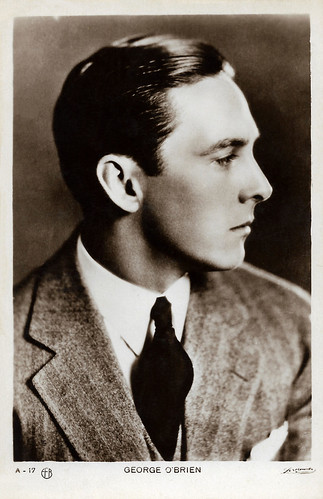
Spanish postcard by EFB, no. A-17.
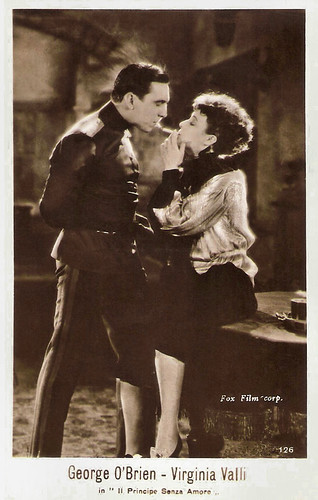
Italian postcard by G.B. Falci, Milano, no. 126. Photo: Fox Film Corp. George O'Brien and Virginia Valli in Paid to Love (Howard Hawks, 1927).

British Real Photograph postcard.

British postcard by Ross Verlag Foreign, no. 3836/2, 1928-1929. Photo: Max Munn Autrey / Fox.

French postcard by A.N., Paris, no. 292. Photo: Max Munn Autrey / Fox.

French postcard by A.N., Paris, no. 313. Photo: Fox Film. Collection: Didier Hanson.

German postcard by Ross Verlag, no. 3170/1, 1928-1929. Photo: Fox. Collection: Didier Hanson.

German postcard by Ross Verlag, no. 4489/1, 1929-1930. Photo: Fox.

German postcard by Ross Verlag, no. 6126/1, 1931-1932. Photo: Fox.
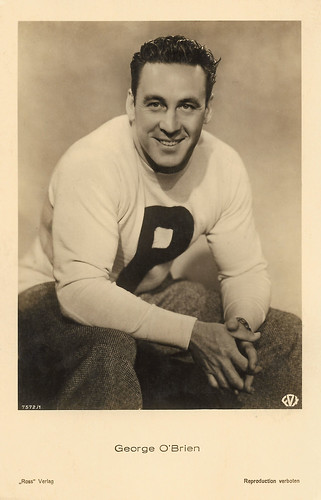
German postcard by Ross Verlag, no. 7572/1, 1932-1933. Photo: Fox.

Dutch postcard, no. 80. Photo: Fox-Film.
Sources: Tony Fontana (IMDb), Find-A-Grave, Wikipedia, and IMDb.
No comments:
Post a Comment